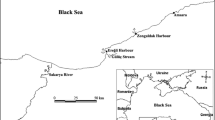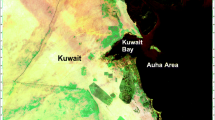Abstract
Pollution of the aquatic environment is a global concern owing to the devastating effects of contaminants whose levels are growing at an alarming rate, and it has become a major threat for marine organisms, as well as to humans as consumers. This study has been carried out on leaping mullet obtained from Aliaga Bay, which is located on the west coast of the Aegean Sea near Izmir and hosts the world’s fifth largest shipyard, plus a broad range of industrial activities, including an oil refinery and a paper factory. The waste from these industries, combined with municipal sewer discharges, is the main cause of pollution in this region. There is no national documentation or research on the determination of pollution resulting from the industrial activities in this area. In the present study, the degree of induction of CYP4501A-associated 7-ethoxyresorufin O-deethylase (EROD) activity and immunochemical detection of CYP1A1 in the liver of leaping mullet (Lisa saliens) were used as biomarkers for the assessment of polycyclic aromatic hydrocarbon (PAH)-type organic pollutants in Aliaga Bay. Mullet caught from different locations of the bay had approximately 52 times more EROD activity than the feral fish sampled from a clean reference site near Foca, Izmir. The results of this study indicate that Aliaga Bay is highly contaminated with PAH-type organic pollutants.
Similar content being viewed by others
References
Aarab, N., Champeau, O., Mora, P., Daubeze, M., Garrigues, P., & Narbonne, J. F. (2004). Scoring approach based on fish biomarkers applied to French River monitoring. Biomarkers, 9, 258–270. doi:10.1080/13547500400015626.
Arinc, E., & Sen, A. (1999). Hepatic cytochrome P4501A and 7-ethoxyresorufin O-deethylase induction in mullet and common sole as an indicator of toxic organic pollution in Izmir Bay, Turkey. Marine Environmental Research, 48, 147–160. doi:10.1016/S0141-1136(99)00038-0.
Arinc, E., Sen, A., & Bozcaarmutlu, A. (2000). Cytochrome P4501A and associated mixed function oxidase induction in fish as a biomarker for toxic carcinogenic pollutants in the aquatic environment. Pure and Applied Chemistry, 72, 985–994. doi:10.1351/pac200072060985.
Arinc, E., Kocabiyik, S., & Su, E. (2001). Induced CYP1A mRNA, protein and catalytic activity in the liver of feral fish, leaping mullet, Liza saliens. Comparative Biochemistry and Biochemistry and Physiology—C Toxicology & Pharmacology, 128, 281–290. doi:10.1016/S1532-0456(01)00201-0.
Bucheli, T. D., & Fent, K. (1995). Induction of cytochrome P450 as a biomarker for environmental contamination in aquatic ecosystems. Critical Reviews in Environmental Science and Technology, 25, 201–268. doi:10.1080/10643389509388479.
Buhler, D. R., & Wang-Buhler, J. L. (1998). Rainbow trout cytochrome P450s: Purification, molecular aspects, metabolic activity, induction and role in environmental monitoring. Comparative Biochemistry and Biochemistry and Physiology—C Toxicology. Pharmacology & Endocrinology, 121, 107–137.
Burke, M. D., & Mayer, R. T. (1974). Ethoxyresorufin: Direct fluorometric assay of microsomal o-dealkylation which is preferentially induced by 3-methylcholanthrene. Drug Metabolism and Disposition: The Biological Fate of Chemicals, 2, 583–588.
Cetin, B., Yatkin, S., Bayram, A., & Odabasi, M. (2007). Ambient concentrations and source apportionment of PCBs and trace elements around an industrial area in Izmir, Turkey. Chemosphere, 69, 1267–1277. doi:10.1016/j.chemosphere.2007.05.064.
Cok, I., Wang-Buhler, J. L., Kedzierski, M. M., Miranda, C. L., Yang, Y. H., & Buhler, D. R. (1998). Expression of CYP2M1, CYP2K1, and CYP3A27 in brain, blood, small intestine, and other tissues of rainbow trout. Biochemical and Biophysical Research Communications, 244, 790–795. doi:10.1006/bbrc.1998.8273.
Fent, K. (2004). Ecotoxicological effects at contaminated sites. Toxicology, 205, 223–240. doi:10.1016/j.tox.2004.06.060.
Fent, K., & Batscher, R. (2000). Cytochrome P4501A induction potencies of polycyclic aromatic hydrocarbons in a fish hepatoma cell line: Demonstration of additive interactions. Environmental Toxicology and Chemistry, 19, 2047–2058. doi:10.1897/1551-5028(2000)019<2047:CPIPOP>2.3.CO;2.
Fernandes, C., Fontainhas-Fernandes, A., Ferreira, M., & Salgado, M. A. (2008). Oxidative stress response in gill and liver of Liza saliens, from the Esmoriz-Paramos Coastal Lagoon, Portugal. Archives of Environmental Contamination and Toxicology, 55, 262–269. doi:10.1007/s00244-007-9108-z.
Ferreira, M., Moradas-Ferreira, P., & Reis-Henriques, M. A. (2006). The effect of long-term depuration on phase I and phase II biotransformation in mullets (Mugil cephalus) chronically exposed to pollutants in River Douro Estuary, Portugal. Marine Environmental Research, 61, 326–338. doi:10.1016/j.marenvres.2005.11.001.
Fuentes-Rios, D., Orrego, R., Rudolph, A., Mendoza, G., Gavilan, J. F., & Barra, R. (2005). EROD activity and biliary fluorescence in Schroederichthys chilensis (Guichenot 1848): Biomarkers of PAH exposure in coastal environments of The South Pacific Ocean. Chemosphere, 61, 192–199. doi:10.1016/j.chemosphere.2005.02.062.
Goksoyr, A., & Forlin, L. (1992). The cytochrome p-450 system in fish, aquatic toxicology and environmental monitoring. Aquatic Toxicology (Amsterdam, Netherlands), 22, 287–312. doi:10.1016/0166-445X(92)90046-P.
Gooch, J. W., Elskus, A. A., Kloepper-Sams, P. J., Hahn, M. E., & Stegeman, J. J. (1989). Effects of ortho- and non-ortho-substituted polychlorinated biphenyl congeners on the hepatic monooxygenase system in scup (Stenotomus chrysops). Toxicology and Applied Pharmacology, 98, 422–433. doi:10.1016/0041-008X(89)90171-3.
Gunther, A. J., Spies, R. B., Stegeman, J. J., Woodiqb, B., Carney, D., Oakden, J., et al. (1997). EROD activity in fish as an independent measure of contaminant-induced mortality of invertebrates in sediment bioassays. Marine Environmental Research, 44, 41–49. doi:10.1016/S0141-1136(96)00101-8.
Humphrey, C. A., Codi King, S., & Klumpp, D. W. (2007). A multibiomarker approach in barramundi (Lates calcarifer) to measure exposure to contaminants in estuaries of Tropical North Queensland. Marine Pollution Bulletin, 54, 1569–1581. doi:10.1016/j.marpolbul.2007.06.004.
Julkunen, A., Schiller, F., Muller, D., Klinger, W., & Hanninen, O. (1986). Monooxygenase activity of fish liver in biomonitoring aquatic environment. Archives of Toxicology, 9, 378–381.
Kirby, M. F., Neall, P., & Tylor, T. (1999). EROD activity measured in flatfish from the area of the Sea Empress oil spill. Chemosphere, 38, 2929–2949. doi:10.1016/S0045-6535(98)00484-6.
Kirikbakan, A. (2004). Sitokrom P4501A ve glutatyon s-transferazların mavri kefal baliginda (Liza saliens) karakterizasyonu ve degisik dokularda immunolojik tanimlanmasi. MSc thesis, Pamukkale University, Faculty of Arts and Sciences, Biology Department, Denizli-Turkey (Turkish).
Kucklick, J. R., Struntz, W. D. J., & Becker, P. R. (2002). Persistent organochlorine pollutants in ringed seals and polar bears collected from Northern Alaska. The Science of the Total Environment, 287, 45–59. doi:10.1016/S0048-9697(01)00997-4.
Laemmli, U. K. (1970). Cleavage of structural proteins during the assembly of the head of bacteriophage T4. Nature, 227, 680–685. doi:10.1038/227680a0.
Lavado, R., Urena, R., Martin-Skilton, R., Torreblanca, A., del Ramo, J., Raldua, D., et al. (2006). The combined use of chemical and biochemical markers to assess water quality along The Ebro River. Environmental Pollution, 139, 330–339. doi:10.1016/j.envpol.2005.05.003.
Lee, S. J., Hedstrom, O. R., Fischer, K., Wang-Buhler, J. L., Sen, A., Cok, I., et al. (2001). Immunohistochemical localization and differential expression of cytochrome P450 3A27 in the gastrointestinal tract of rainbow trout. Toxicology and Applied Pharmacology, 177, 94–102. doi:10.1006/taap.2001.9289.
Levine, S. L., & Oris, J. T. (1999). CYP1A expression in liver and gill of rainbow trout following waterborne exposure: Implications for biomarker determination. Aquatic Toxicology (Amsterdam, Netherlands), 46, 279–287. doi:10.1016/S0166-445X(98)00124-6.
Levine, S. L., Oris, J. T., & Wissing, T. E. (1994). Comparison of mono-oxygenase induction in gizzard shad (Dorosoma cepedianum) following intraperitoneal injection or continuous water-borne exposure with BaP: Temporal and concentration-dependent studies. Aquatic Toxicology (Amsterdam, Netherlands), 30, 61–75. doi:10.1016/0166-445X(94)90006-X.
Lowry, O. H., Rosenburg, N. J., Farr, A. L., & Randall, R. J. (1951). Protein measurements with folin–phenol reagent. The Journal of Biological Chemistry, 193, 265–275.
Morales-Caselles, C., Jimenez-Tenorio, N., Riba, I., Sarasquete, C., & DelValls, T. A. (2007). Kinetic of biomarker responses in juveniles of the fish Sparus aurata exposed to contaminated sediments. Environmental Monitoring and Assessment, 131, 211–220. doi:10.1007/s10661-006-9469-1.
Narbonne, J. F., Garrigues, P., & Ribera, D. (1991). Mixed-function oxygenase enzymes as tools for pollution monitoring: Field studies on the French Coast of the Mediterranean Sea. Comparative Biochemistry and Physiology. Toxicology & Pharmacology, 100, 37–42.
Nilsen, B. M., Berg, K., & Goksoyr, A. (1998). Induction of cytochrome P450 1A in fish, a biomarker for environmental pollution. Methods in Molecular Biology (Clifton, N.J.), 107, 423–438.
Orrego, R., Burgos, A., Moraga-Cid, G., Inzunza, B., Gonzalez, M., Valenzuela, A., et al. (2006). Effects of pulp and paper mill discharges on caged rainbow trout (Oncorhynchus mykiss): Biomarker responses along a pollution gradient in The Biobio River, Chile. Environmental Toxicology and Chemistry, 25, 2280–2287. doi:10.1897/05-385R.1.
Ozmen, M., Ayas, Z., Gungordu, A., Ekmekci, G. F., & Yerli, S. (2008). Ecotoxicological assessment of water pollution in Sariyar Dam Lake, Turkey. Ecotoxicology and Environmental Safety, 70, 163–173. doi:10.1016/j.ecoenv.2007.05.011.
Pacheco, M., & Santos, M. A. (1998). Induction of liver EROD and erythrocytic nuclear abnormalities by cyclophosphamide and PAHs in Anguilla anguilla L. Ecotoxicology and Environmental Safety, 40, 71–76. doi:10.1006/eesa.1998.1644.
Sandvik, M., Beyer, J., & Goksoyr, A. (1997). Interaction of benzo(a)pyrene 2,3,3,4,4,5-hexachlorobiphenyl (PCB-156) and cadmium on biomarker responses in flounder. Biomarkers, 2, 153–160. doi:10.1080/135475097231689.
Schenkman, J. B., & Cinti, D. L. (1978). Preparation of microsomes with calcium. Methods in Enzymology, 52, 83–89. doi:10.1016/S0076-6879(78)52008-9.
Sen, A., & Arinc, E. (1998). Preparation of highly purified cytochrome P4501A1 from leaping mullet (Liza saliens) liver microsoms and its biocatalytic, molecular and immunochemical properties. Comparative Biochemistry and Physiology. Part C, Pharmacology, Toxicology & Endocrinology, 121, 249–265. doi:10.1016/S0742-8413(98)10046-4.
Sen, A., & Arinc, E. (2000). Further immunochemical and biocatalytic characterization of CYP1A1 from feral leaping mullet liver (Liza saliens) microsomes. Comparative Biochemistry and Physiology. Toxicology & Pharmacology, 126, 235–244.
Sen, A., & Kirikbakan, A. (2004). Biochemical characterization and distribution of glutathione S-transferases in leaping mullet (Liza saliens). Biochemistry. Biokhimiia, 69, 993–1000. doi:10.1023/B:BIRY.0000043541.80075.fd.
Sen, A., Hu, C. H., Urbach, E., Wang-Buhler, J. L., Yang, Y. H., Arinc, E., et al. (2001). Cloning, sequencing and characterization of CYP1A1 cDNA from leaping mullet (Liza saliens) liver and implications for the potential functions of its conserved amino acids. Journal of Biochemical and Molecular Toxicology, 15, 243–255. doi:10.1002/jbt.10005.
Sindermann, C. J., Lloyd, R., Vader, S. L., & Bourne, W. R. P. (1982). Implications of oil pollution in production of disease in marine organisms [and discussion]. Philosophical Transactions of the Royal Society of London. Series B. Biological Sciences, 297, 385–399. doi:10.1098/rstb.1982.0049.
Stegeman, J. J. (1987). Monooxygenase systems in marine fish. In C. S. Giam, & L. Ray (Eds.), Pollutant studies in marine animals (pp. 65–95). West Palm Beach: CRC.
Stegeman, J. J., & Kloepper-Sams, P. J. (1987). Cytochrome P-450 isozymes and monooxygenase activity in aquatic animals. Environmental Health Perspectives, 71, 87–95. doi:10.2307/3430416.
Stegeman, J. J., & Lecht, J. J. (1991). Cytochrome P-450 monooxygenase systems in aquatic species: Carcinogen metabolism and biomarkers for carcinogen and pollutant exposure. Environmental Health Perspectives, 90, 101–109. doi:10.2307/3430851.
Towbin, H., Staehelin, T., & Gordon, J. (1979). Electrophoretic transfer of proteins from polyacrylamide gels to nitrocellulose sheets: Procedure and some applications. Proceedings of the National Academy of Sciences of the United States of America, 76, 4350–4354. doi:10.1073/pnas.76.9.4350.
Wafo, E., Sarrazin, L., & Diana, C. (2005). Accumulation and distribution of organochlorines (PCBs and DDTs) in various organs of Stenella coeruleoalba and a Tursiops truncatus from mediterranean littoral environment (France). The Science of the Total Environment, 348, 115–127. doi:10.1016/j.scitotenv.2004.12.078.
Whyte, J. J., Jung, R. E., & Schmitt, C. J. (2000). Ethoxyresorufin o-deethylase (EROD) activity in fish as a biomarker of chemical exposure. Critical Reviews in Toxicology, 30, 347–570. doi:10.1080/10408440091159239.
Author information
Authors and Affiliations
Corresponding author
Rights and permissions
About this article
Cite this article
Sen, A., Ulutas, O.K., Tutuncu, B. et al. Determination of 7-ethoxyresorufin-o-deethylase (EROD) induction in leaping mullet (Liza saliens) from the highly contaminated Aliaga Bay, Turkey. Environ Monit Assess 165, 87–96 (2010). https://doi.org/10.1007/s10661-009-0928-3
Received:
Accepted:
Published:
Issue Date:
DOI: https://doi.org/10.1007/s10661-009-0928-3




